#the borjigin mongols
Explore tagged Tumblr posts
Text

As we have just completed migrating and landing ourselves in a new area, for the time being we are back to being The Borjigin Mongols. We are currently located in the Central Steppe where it is the season of Everlasting Summer. Temujin is currently the 3rd largest Nomad in The Great Steppe.

Now we are also able to re-negotiate our Vassal Contract with Chieftain Jamukha of the Jadaran Mongols. We give him Guaranteed Kurultai Rights in exchange for High Herd Tithes and Low Nomadic Taxes.
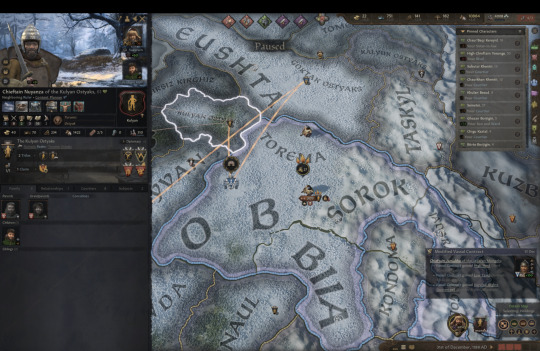
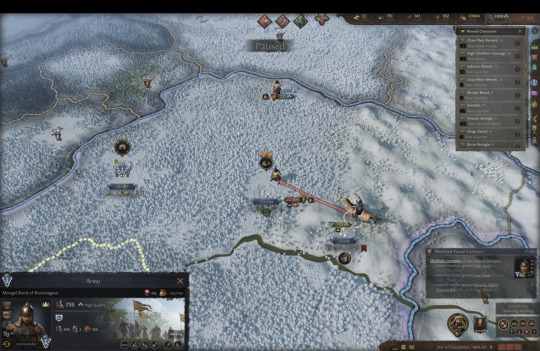
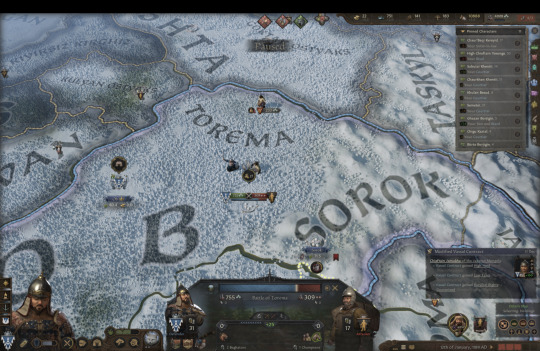
Meanwhile, our lands are being raided by our north-western neighbour Chieftain Nuyanza of the Kulyan Ostyaks. We send in our hired mercenaries, the Mongol Band of Karatsagaan, all 755 men-strong with Temujin at the helm to disrupt the raiders. We managed to defeat the raiders in Torema and send them packing.

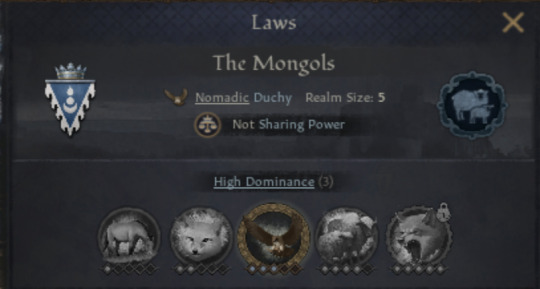
Next, we change our Dominance Level from Limited Dominance to High Dominance, increasing our Domain Limit to 4. Instead of a Snow Fox, we are now an Eagle. Our migration can now target De Jure Kingdom Titles. However, High Dominance did not make us into a Khan.
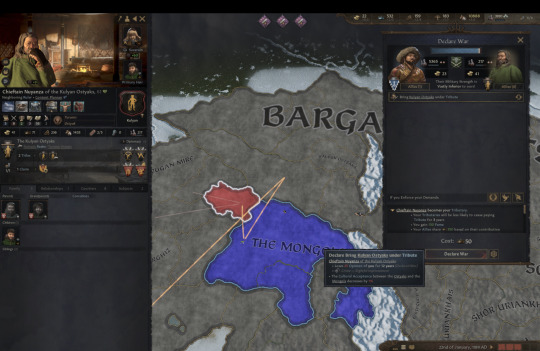
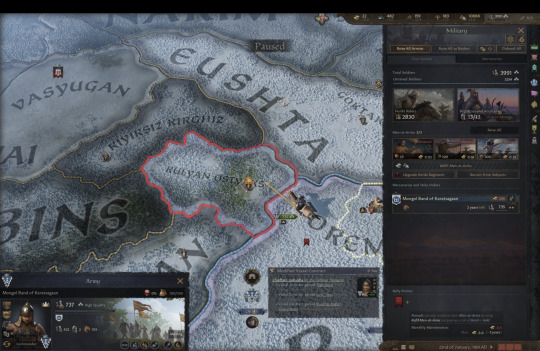
After wiping his army during the raid, we decide to bring our troublesome neighbour Chieftain Nuyanza of the Kulyan Ostyaks under Tribute. We decide to send our mercenaries, the Mongol Band of Karatsagaan to deal with the Kulyan Ostyaks again.
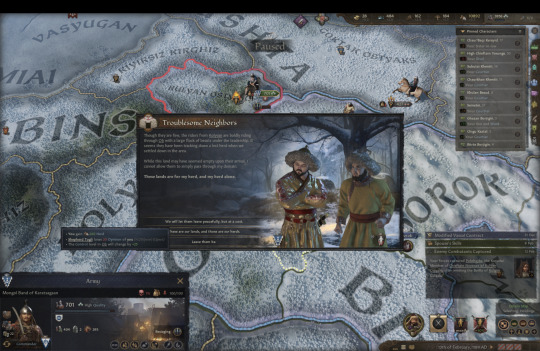
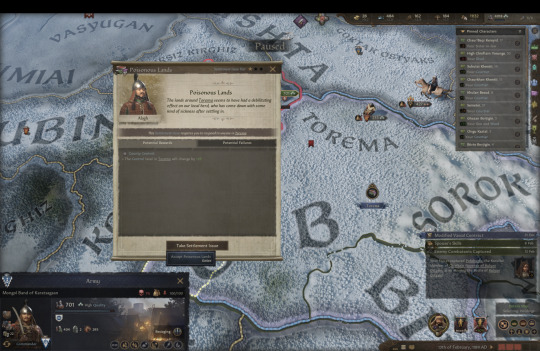
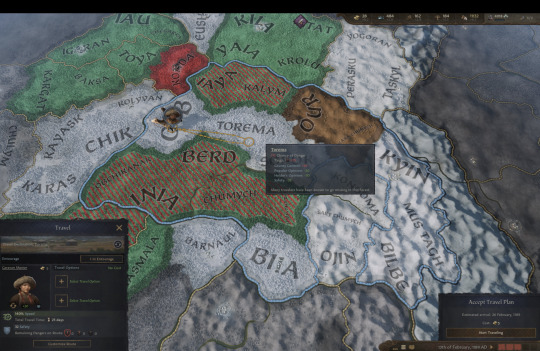

We encounter another sort of Troublesome Neighbours. To the West of Ob, the Shepherd Togli from Kolyvan tries to pass through our land with his flock of beasts. We stop him and confiscate some of his Herd.
Next, the lands around Torema seem to be poisoning and sickening our Herd after they settled in. We travel from Ob to Torema where the terrain is all Taiga. We have no choice but to slaughter 150 Herd to prevent the contiguous spread of whatever disease is plaguing them.

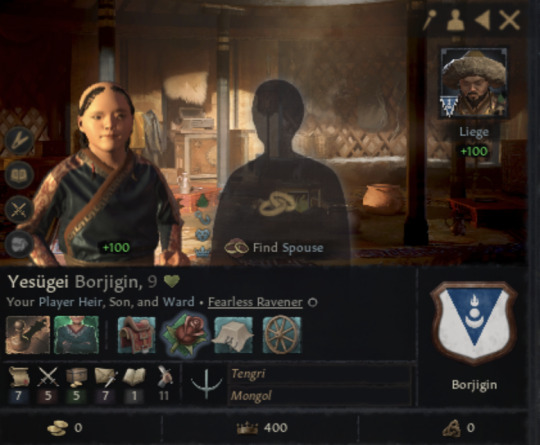
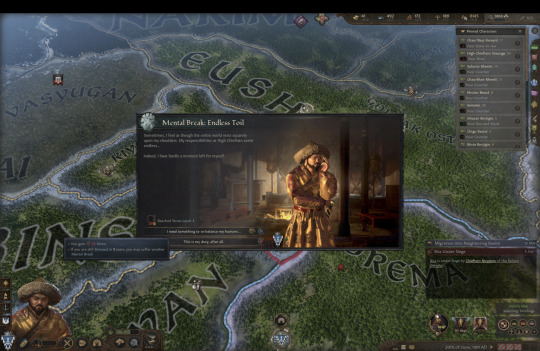
Yesugei became Paranoid, suspecting Temujin of staging an encounter with a wounded doe as some kind of test. We teach Yesugei a lesson that he could have felled the animal himself. He became Ambitious, which is a better trait to have.
This puts Temujin over the edge of stress, feeling the Endless Toil of his responsibilities as High Chieftain. We decide against consuming Hashish, as it lowers Stewardship and Learning.

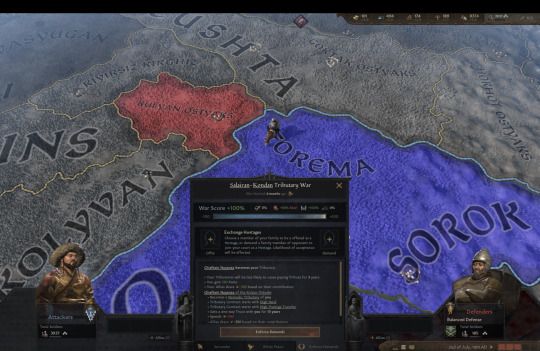
After the successful siege, we ransom the heir of Chieftain Nuyanza, Odeg Kulyan for 43 gold. Then we end the Salairan-Kondan Tributary War in victory.
#ck3#crusader kings iii#crusader kings 3#temujin#genghis khan#khans of the steppe#the borjigin mongols#the mongols#tributary
0 notes
Text

1 note
·
View note
Text
1162 - 1206 - This is actually the story of Temüjin, a young boy born of noble stock, and outcast following his father's death. We track Temüjin's incredible rise from humility to grandeur, and find out how he become Genghis Khan.
#genghis khan#mongol empire#khentii#mongolia#temujin#borjigin#history#medievalhistory#historyoftheworld#worldhistory
0 notes
Note
what's up with the shaved head? I didn't see that detail in the book but I've seen a bunch of people use it, what's that about?
*slaps esen's bald head like a car salesman*
it's in reference to a historical mongol hairstyle worn by yuan-dynasty nobility (not 100% sure this also translated to common mongolians) popularised by genghis khan. this particular style of queue involves shaving the top of the head and leaving a forehead lock as well as the sides. the sides are then braided into 2 or more looped braids.
For reference, see this painting from 1280 of khublai khan hunting:

note the looped braids and shaved heads. (maybe zoom a bit lol).
lastly, shaved or partially shaved queues and hairstyles are of massive historical not only to borjigin mongols but to a great number of central asian peoples and ethnicities, stretching all the way to eastern europe with the cossacks of the don and modern-day eastern ukraine.
if i remember correctly, the canon hair descriptions of esen include braids and colourful beads, but i don't ever remember text about missing or present hair on the top of the head.
#i think on twitter spc commented on ash-and-starlight's fanart of an unshaved esen that this is how they envisioned him?#but i Do Not Care. thank you for your wonderful work spc but i'll take it from here#and by 'it' i mean. well.#swbts#hwdtw#esen temur#the radiant emperor
24 notes
·
View notes
Text


Batu Khan: The Mongol Prince Who Redefined Eurasia
Few figures in world history have had a deeper yet more understated influence than Batu Khan, the grandson of Genghis Khan and founder of the Golden Horde. Batu's military campaigns, political vision, and cultural legacy forever altered the trajectory of Eurasian history, stretching from the steppes of Mongolia to the forests of Russia, and into the heart of Europe. His conquests set in motion vast demographic shifts, shaped the identity of Russia, and established the Tatar cultural footprint that endures to this day.
The Rise of Batu Khan
Born around 1207, Batu Khan was the son of Jochi, Genghis Khan's eldest (and possibly illegitimate) son. As part of the powerful Borjigin dynasty, Batu inherited the westernmost portion of the Mongol Empire. In the 1230s, under orders from the Great Khan Ögedei, Batu led one of the largest military expeditions in history into Eastern Europe. His armies swept through Central Asia, the Caucasus, the Rus' principalities, and deep into Poland and Hungary.
The sacking of cities like Kiev in 1240 marked the collapse of Kievan Rus' and began a new era in Eastern European history. Batu stopped short of conquering Vienna due to the death of Ögedei in 1241, and instead of returning to Mongolia, he established his own semi-independent state along the Volga River: the Golden Horde.
Migration and Demographic Transformation
Batu Khan's campaigns and rule triggered massive demographic upheaval. Cities were destroyed, populations massacred or displaced, and entire regions depopulated. Many Slavic peoples migrated northward into forested regions, sowing the seeds for the rise of Muscovy.
Meanwhile, the Mongol elite settled among Turkic tribes, creating a cultural fusion that would evolve into the Tatar identity. Administrators, merchants, and artisans followed the Horde across Eurasia, facilitating an unprecedented movement of people, languages, and ideas. The very fabric of Eastern Europe changed under Batu's influence.
The Golden Horde and Tatar Identity
Although Mongol by blood, Batu's Golden Horde rapidly absorbed Turkic and Islamic influences, becoming what Europeans would come to call "Tatar." The Horde was initially Tengrism in faith but tolerated Orthodox Christianity, Judaism, and later embraced Islam, particularly under Batu's brother Berke.
Tatar society was built on steppe traditions: nomadism, warrior codes, hospitality, and a sense of honor rooted in kinship and allegiance. Women in Tatar aristocracy held influence and occasionally ruled in the absence of their husbands. The Horde's capital, Sarai, became a multicultural hub of trade and diplomacy, linking China with the Black Sea.
Tatar culture emphasized oral storytelling, horsemanship, and diplomacy. Their aesthetic legacy survives in Islamic architecture, craftwork, and the organization of urban centers across the Volga and Ural regions. Over time, the Tatars formed the core of a distinct Eurasian cultural identity.
The Russian-Tatar Synthesis
Batu's legacy in Russia is complex. While his invasions devastated Rus', his rule indirectly encouraged the rise of a centralized Russian state. Mongol administrative practices—tribute collection, census-taking, military conscription—were adopted by Rus' princes. Moscow, a minor outpost, grew powerful as a loyal tributary of the Horde.
The prolonged contact between Mongols, Tatars, and Russians led to a unique cultural synthesis. Military organization, political centralism, and aspects of language and dress were influenced by the Horde. Intermarriage and cultural osmosis blurred ethnic lines.
As the Golden Horde fragmented, many Tatar khanates emerged, such as Kazan and Crimea, which continued to influence Russian political and military strategy. Even after the fall of these khanates to Ivan the Terrible, their customs, administrative knowledge, and population remained part of the Russian imperial structure.
Modern Legacy: Tatar Influence in Russia Today
Today, the Tatar people remain the largest minority group in Russia. The Republic of Tatarstan, with its capital in Kazan, stands as a vibrant center of Tatar culture, language, and Islamic heritage. Tatar customs, such as cuisine (chak-chak, pilaf), music, and Islamic festivals, are deeply interwoven into the broader Russian mosaic.
Tatar intellectuals, writers, and scientists have contributed significantly to Russian and Soviet history. Kazan itself has been a symbol of religious coexistence, where Orthodox cathedrals and mosques rise within view of each other.
#book cover#literature#book#bookworm#history#Batu-Khan#Batu Han#Mongolian#Tatar#Tatarstan#Russian history#Dschenghis Khan#Cengiz Han
2 notes
·
View notes
Text
“When entering her bedroom,
I inhale sadness.
I climb behind her phoenix bed-curtains,
Yet they hang to no avail.
The romance of the spring breeze and autumn moon all ends here.
Summer days and winter nights spent with her will never come again”
-’Expressing My Grief”, Qianlong Emperor
The Qianlong Emperor (r. 1735-1796) wrote this poem after the death of his first empress, Empress Xiaoxianchun of the Fuca clan.
Unfortunately, Empress Xiaoxianchun’s personal name was never recorded and therefore lost to time; however, we do know she had an elegant and dignified personality.
Empress Xiaoxianchun married the Emperor on September 3, 1727 when she was only 15 years old. Their marriage was said to be happy and full of love. It is said they would spend time together by painting, reciting poems, and playing instruments. Emperor Qianlong would often go to her for advice.
The Empress led a rather frugal life for her station. While many women of the Imperial Harem would adorn themselves with elaborate hairpins and jewels the Empress would wear artificial flowers in her hair. When her husband informed her of how his Manchurian ancestors were too poor to afford cloth and would instead use deer hide to sew their pouches, she made him one of deer hide as well. It is said he deeply cherished the gift and always carried it with him.
Empress Xiaoxianchun bore four children over the course of her marriage, two daughters and two sons. Unfortunately, three of the four would precede her in death. Her only surviving child, Princess Hejing of the First Rank, would marry into the Mongol Khorchin Borjigin clan sometime in early 1747.
The deaths of three of her children gradually led to the weakening of her health. Just a few short months after the death of her infant son, Yongcong, Empress Xiaoxianchun would tragically pass away from malarial fever while on a boat tour of the eastern province of Shandong. She was only 36 years old.
Her death devastated the Qianlong Emperor. He had all of belongings enshrined for 40 years and visited her grave every year. He had two of his sons removed from being potential successors when he found out they had not mourned appropriately and severely punished court officials who shaved their heads during the mourning period. He visited her grave every year until his own death in 1799.
13 notes
·
View notes
Text
Empress Xiaoxianchun of the Qing Dynasty (1738-1748)

Unfortunately, Empress Xiaoxianchun’s personal name was never recorded and therefore lost to time; however, we do know she had an elegant and dignified personality.
She was born on 28 March 1712 to the Manchu Bordered Yellow Banner Fuca clan. Her father was a third rank military official and held the title of a first rank duke. She had nine brothers and one sister.
Lady Fuca married the future Qianlong Emperor on 3 September 1727 when she was only 15 years old. Their marriage was happy and full of love. It is said they would spend time together by painting, reciting poems, and playing instruments. Emperor Qianlong would often go to her for advice.
She would be instated as Empress Consort in January of 1738 after her husband ascended the throne. The Empress led a rather frugal life for her station. While many women of the Imperial Harem would adorn themselves with elaborate hairpins and jewels the Empress would wear artificial flowers in her hair. When her husband informed her of how his Manchurian ancestors were too poor to afford cloth and would instead use deer hide to sew their pouches, she made him one of deer hide as well. It is said he deeply cherished the gift and always carried it with him.
Empress Xiaoxianchun bore four children over the course of her marriage, two daughters and two sons. Unfortunately, three of the four would precede her in death. Her only surviving child, Princess Hejing of the First Rank, would marry into the Mongol Khorchin Borjigin clan sometime in early 1747.
The deaths of three of her children gradually led to the weakening of her health. Just a few short months after the death of her infant son, Yongcong, Empress Xiaoxianchun would tragically pass away from malarial fever while on a boat tour of the eastern province of Shandong. She was only 36 years old.
Her death devastated the Qianlong Emperor. He had all of belongings enshrined for 40 years and visited her grave every year. He had two of his sons removed from being potential successors when he found out they had not mourned appropriately and severely punished court officials who shaved their heads during the mourning period. He visited her grave every year until his own death in 1799 and wrote poems to commemorate her.
Titles:
Lady Fuca (from March 1712)
Primary Consort (from Sept 1727)
Empress (from Jan 1738)
Empress Xiaoxian (posthumous from June 1748)
Empress Xiaoxianchun (posthumous from 1799)
This post may look familiar as I have previously written about Empress Xiaoxianchun on my other profile when I posted one of her husband's poems that was dedicated to her.
2 notes
·
View notes
Text
MANDUKHAI KHATUN // QUEEN
“She was the great-great-granddaughter of Genghis Khan, and a strong fighter. She insisted that any man who wished to marry her must defeat her in wrestling, but any man she beat would have to give her a horse. She wound up with 1,000 horses. With command over the Mongols, Mandukhai made war with the Oirats and defeated them. Her stunning victory over the Oirats brought back great reputation of the Borjigins and united Mongolia for the first time in more than one hundred years. She eventually married Batmunkh. Not long after, the Oirats again rebelled and raided the Eastern Mongols. Mandukhai lead the great army against them. She defeated several Ming dynasty attacks and protected the Northern Yuan, she wore the helmets and the sword and fought with the Ming soldiers. She was pregnant, but still fought and delivered twin boys during a long battle. The Western Mongols were subdued once again. From 1480, Dayan Khan and Mandukhai increased the pressure on the Ming territory because they closed the border trade and killed a Northern Yuan envoy. To contain her, the Ming rapidly expanded the Great Wall. She reoccupied Ordos area and stationed soldiers there to keep watch on the Ming. She reenthroned Dayan Khan at the Eight White Yurts in Ordos but they had to flee a Ming attack. Mandukhai with Dayan Khan went to the Kherlen River in 1501 though her husband continued raids on the Ming dynasty.”


2 notes
·
View notes
Text
Nicknames for borzois
From time immemorial, it has been customary for borzois to give nicknames that carry a certain semantic and emotional load. These traditions continue to this day. True, the “theme” of nicknames has changed significantly over time.
Since past centuries, the speed, vigilance and dexterity of these dogs have traditionally been reflected in the nicknames of borzois: Bystryy(fast), Veter(wind), Veterok(breeze), Vikhr'(whirlwind), Zorkyy(sharp-sighted), Krylat(winged), Lovkiy(dexterous), Polyot(flight), Prytkiy(quick), Bystra(female version of fast), Lyotka(flying), Krylatka(female version of winged), Provorka(agile), Pul'ka(bullet), Rezva(frisky), Shustra(nimble).
The nicknames given by the names of birds echo this theme: Berkut(golden eagle), Krechet(gyrfalcon), Korshun(kite), Sokol(falcon), Oryol(eagle), Strepet(little bustard), Golubka(female pigeon), Ptashka(birdie), Chayka(gull).
One of the indispensable qualities of the old Russian borzois - anger towards the beast - was reflected in the nicknames: Zver'(beast), Zlobach(vicious), Lyutyy(fierce), Svirep(ferocious), Lyutaya(female version of fierce), Tiranka(female tyrant).
A very peculiar approach of ancient hunters to the names of borzois is visible in the use of imperative verbs: Dogonyay(catch up), Doyezzhay(reach),Zamechay(notice), Nakryvay(cover), Porazhay(hit), Primechay(take notice), Raskiday(scatter), Sokrushay(crush), Khvatay(grab). Thus, hope was expressed for the future outstanding qualities of the dog.
Often the nickname was supposed to reflect the prowess and courage of the dog, which, of course, does not give the beast a descent during the persecution: Karay(punish), Katay(ride), Obizhay(offend), Nalyot(raid), Pobedim(win), Udaloy(daring), Shvyrok(throw), Nalyotka(female version of raid), Otvaga(courage), Raskida(female version of scatter), Slava(glory), Udalaya(female version of daring).
Oriental nicknames have always been quite popular with Russian borzois: Abrek(is a North Caucasian term used for a lone North Caucasian warrior living a partisan lifestyle outside power and law and fighting for a just cause), Agakhan(is a title held by the Imām of the Nizari Ismāʿīli Shias), Alan(In honor of a nomadic tribe in Asia), Anchar(antiaris), Bulat( 1)male name of Persian origin, which was borrowed by the Turkic peoples. The etymological meaning of the name is "steel". From the Turks, the name Bulat came to Rus', where it was used before the spread of Christianity. 2) is a type of steel alloy known in Russia from medieval times), Kuchum(was the last Khan of Siberia who ruled from 1563 to 1598), Lezgin(In honor of the Dagestan people, one of the indigenous people of the Caucasus), Nayan(was a prince of the Borjigin royal family of the Mongol Empire), Sultan, Turkmen(are a Turkic ethnic group native to Central Asia), Shaitan, Gulji(Presumably a goat), Fatma(Arabian woman name).This partly indirectly confirms the hypothesis of the eastern route of penetration of sighthounds into Russia. Well, after quite a lot of oriental sighthounds were brought in the 19th century, as already noted, the number of such nicknames naturally increased.
Many nicknames displayed character traits, one might say, desirable for a borzoi: Azarnoy(venturous), Nakhal(smart aleck), Razboy(robbery), Retivyy(mettled), Smelyy(brave), Buyana(brawl), Zadira(bully), Nagla(Insolent), Plutovka(cheat), Shel'ma(rogue), Shalun'ya(naughty). And this approach is understandable and traditional.
However, among modern nicknames, characteristics that are not very desirable for a greyhound began to appear more and more often: Dikar'(savage), Dobryak(kindley), Dikarka( female version of savage), Laska(caress), Nedotroga(touchy), Tikhonya(cuiet).Of course, the owners have always cherished and protected their dogs.
And an indicator of this attitude are the nicknames that emphasize the value of the dog: Bestsen(priceless), Dorogoy(dear), Podar(gift), Lyubim(loved), Serdechnyy (hearty), Yakhont(one of the obsolete names for the red and blue jewelry minerals corundum), Almazka(diamond), Biryuza(turquoise), Brasletka(bracelet), Nagrada(award), Serebryanka(silver), Yashma(jasper).
The spectacular appearance of sighthounds, especially Russian borzois with their luxurious coat, impresses even the inexperienced. And it is not for nothing that a fairly large number of nicknames, both in the past and now, emphasize this beauty. Here are just a few of them: Krasavchik(handsome), Ladnyy(fine), Prigozhay(comely), Blyostka(Glitter), Divnaya(marvelous), Igrushka(toy), Krasa(beauty), Krasotka(beauty).
In our times, nicknames taken from the names of plants of our homeland have become widespread among borzois: Bagul'nik(Labrador tea), Klyon(Maple), Kovyl'(feather grass), Lyutik(buttercup), Shalfey(sage), Beryozka(Birch), Yolka(Christmas tree), Kalina(guelder rose), Medunitsa(lungwort), Melissa(lemon balm).
As well as lakes, rivers and other geographical names of Russia: Baikal, Valdai, Don, Sayan, Angara, Volga, Katun.
Borzois, like some other domestic breeds of hunting dogs, often have nicknames that reflect natural phenomena: Grom(thunder), Iney(hoarfrost), Rassvet(dawn), Tuman(fog), Volna(wave), Groza(thunderstorm), Dymka(mist), Metel'(blizzard), Purga(snowstorm).
It can be seen under the impression that the Russian nobility was engaged in hunting with borzois in past centuries, a lot is now found among borzois and "titled persons": Barin, Knyaz', Sudar', Tsarevich, Tsar, Boyarynya, Grafinya(Countess), Knyazhna, Printsessa(Princess).
Borzois are considered an ancient Russian breed, the personification of old times. And, probably, the appearance of nicknames that came from legends, fairy tales and from the names of historical figures is connected with this: Berendey, Yermak, Kudiyar, Leshiy, Orlov, Sadko, Bylina, Skazka, Snegurochka.
1 note
·
View note
Text
Events 6.14 (before 1910)
1158 – The city of Munich is founded by Henry the Lion on the banks of the river Isar. 1216 – First Barons' War: Prince Louis of France takes the city of Winchester, abandoned by John, King of England, and soon conquers over half of the kingdom. 1276 – While in exile in Fuzhou, away from the advancing Mongol invaders, the remnants of the Song dynasty court hold the coronation ceremony for Emperor Duanzong. 1285 – Second Mongol invasion of Vietnam: Forces led by Prince Trần Quang Khải of the Trần dynasty destroy most of the invading Mongol naval fleet in a battle at Chuong Duong. 1287 – Kublai Khan defeats the force of Nayan and other traditionalist Borjigin princes in East Mongolia and Manchuria. 1381 – Richard II of England meets leaders of the Peasants' Revolt at Mile End. The Tower of London is stormed by rebels who enter without resistance. 1404 – Welsh rebel leader Owain Glyndŵr, having declared himself Prince of Wales, allies himself with the French against King Henry IV of England. 1618 – Joris Veseler prints the first Dutch newspaper Courante uyt Italien, Duytslandt, &c. in Amsterdam (approximate date). 1645 – English Civil War: Battle of Naseby: Twelve thousand Royalist forces are beaten by fifteen thousand Parliamentarian soldiers. 1658 – Franco-Spanish War: Turenne and the French army win a decisive victory over the Spanish at the battle of the Dunes. 1690 – King William III of England (William of Orange) lands in Ireland to confront the former King James II. 1775 – American Revolutionary War: the Continental Army is established by the Continental Congress, marking the birth of the United States Armed Forces. 1777 – The Second Continental Congress passes the Flag Act of 1777 adopting the Stars and Stripes as the Flag of the United States. 1789 – Mutiny on the Bounty: HMS Bounty mutiny survivors including Captain William Bligh and 18 others reach Timor after a nearly 7,400 km (4,600 mi) journey in an open boat. 1800 – The French Army of First Consul Napoleon Bonaparte defeats the Austrians at the Battle of Marengo in Northern Italy and re-conquers Italy. 1807 – Emperor Napoleon's French Grande Armée defeats the Russian Army at the Battle of Friedland in Poland (modern Russian Kaliningrad Oblast) ending the War of the Fourth Coalition. 1821 – Badi VII, king of Sennar, surrenders his throne and realm to Ismail Pasha, general of the Ottoman Empire, bringing the 300 year old Sudanese kingdom to an end. 1822 – Charles Babbage proposes a difference engine in a paper to the Royal Astronomical Society. 1830 – Beginning of the French colonization of Algeria: Thirty-four thousand French soldiers begin their invasion of Algiers, landing 27 kilometers west at Sidi Fredj. 1839 – Henley Royal Regatta: the village of Henley-on-Thames, on the River Thames in Oxfordshire, stages its first regatta. 1846 – Bear Flag Revolt begins: Anglo settlers in Sonoma, California, start a rebellion against Mexico and proclaim the California Republic. 1863 – American Civil War: Second Battle of Winchester: A Union garrison is defeated by the Army of Northern Virginia in the Shenandoah Valley town of Winchester, Virginia. 1863 – Second Assault on the Confederate works at the Siege of Port Hudson during the American Civil War. 1872 – Trade unions are legalized in Canada. 1888 – The White Rajahs territories become the British protectorate of Sarawak. 1900 – Hawaii becomes a United States territory. 1900 – The second German Naval Law calls for the Imperial German Navy to be doubled in size, resulting in an Anglo-German naval arms race. 1907 – The National Association for Women's Suffrage succeeds in getting Norwegian women the right to vote in parliamentary elections.
0 notes
Text
Genghis Khan: The Birth of the Mongol Empire
Early Life and Rise to Power Genghis Khan, born Temujin around 1162 in the harsh, unforgiving steppes of Mongolia, began life in circumstances that seemed unlikely to lead to greatness. His early years were marked by turmoil and adversity, conditions that would forge him into a resilient and cunning leader. Temujin was the son of Yesugei, a minor chieftain of the Borjigin clan, and Hoelun, his…
0 notes
Text
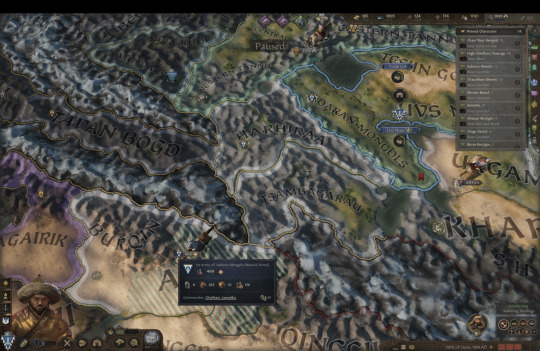

As mentioned in the previous post, Chieftain Jamukha has landed himself into a big quandry. By attacking Chieftain Kitbuqa of the Betegin Naimans who were already at war with The Naimans, essentially when The Naimans won their conquest war of the Betegin Naimans land, that meant Chieftain Jamukha was suddenly fighting against The Naimans for the Betegin Naimans' former land, Urgamal. This pits Chieftain Jamukha's 466 soldiers against The Naimans' 3029 force. This is none of our business, except it very well soon will be as you will see in a moment...

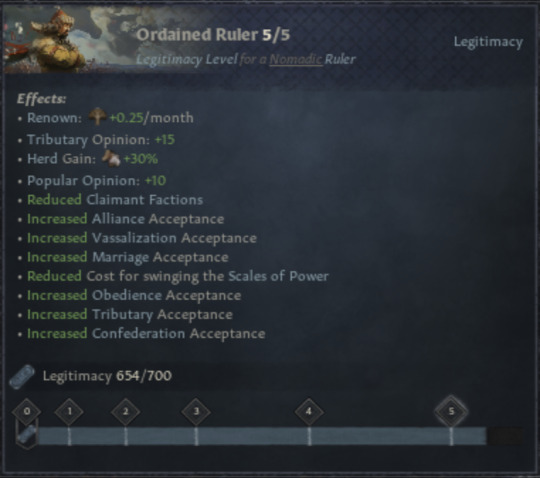

Our original Legitimacy Level was True Ruler (4/5) after the victory over The Naimans which gave us 654/1000 Legitimacy. However, on our first play session (which failed) for the day, when we migrated from the Eastern Steppe to the Central Steppe, we became a temporary Unlanded Nomadic Ruler. This made our Legitimacy Level at the maximum Ordained Ruler (5/5) at 654/700 Legitimacy. We therefore unofficially secured the achievement "Divine Right".



Our current date is 19th June 1188, and our Current Season of Abundant Grazing in the Eastern Steppe ends on 1st October 1188. Usun Besud, our Stargazer predicts that the Next Season in the Eastern Steppe is a 97% chance of a Severe Drought. So we look west to the Central Steppe which is currently Abundant Grazing as well, but has a different set of predictions for Next Season. Usun tells us that the Central Steppe would be 84% chance Everlasting Summer!
So we set out to migrate to another place in the Central Steppe that has relatively high overall County Fertility. On our first failed play session, we migrated to Kulyndy Steppe where the current ruler was losing a war. We ended up migrating into a situation where we inherited his failing war and had our holdings sieged down and our people captured.
On our 2nd play session, we choose instead to migrate to Duchy of Salair where Chieftain Oshmar of the Hokhot Ostyaks resides. We do not even have to offer any Herd or Gold for him to willingly vacate his land as he is intimidated by us. Best of all, he has no wars and has 2 truces.

We pack up and leave Uvs Nuur behind. Our destination is a 5 month journey.

Just as we set out for our new home, Chieftain Jamukha barges into Temujin's tent requesting aid as his Ally and Blood Brother in his godforsaken war with The Naimans. The penalty for refusal is high - losing 350 Fame, 500 Devotion and a negative modifier of "Abandoned Blood Brotherhood" for 25 years. On top of that, Jamukha would become our Rival. To prevent that, we have no choice but to accept and provide aid to the foolish Chieftain Jamukha - always picking the best timing to fuck up things for us.

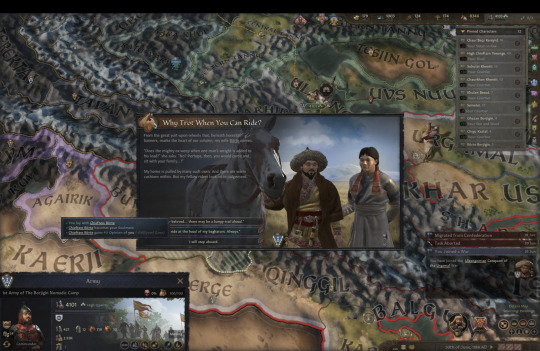


Onroute to our new migration home:
Temujin stops to talk to our Friend and Acclaimed Baghatur Nayaga about the changing season to Summer.
Temujin and High Chieftess Borte shared an especially bumpy ride in a great yurt pulled by a team of oxen, becoming Soulmates in the process.
Temujin intimidates the local "ruler", Shepherd Munglig into giving Temujin the use of his best lands to graze Temujin's Herd as they pass by.

Soon, it is 1st October 1188, and the Eastern Steppe is hit by a Severe Drought. We have decided to escape these lands to the Central Steppe where it is an Everlasting Summer, and we are still in the process of migrating.




As we near our migration destination, our Mother Hoelun reports that some of our Herd has fallen ill. We lost 112 Herd and after deciding to cull the sick animals to prevent the spread of disease, we lost another 225 Herd.
In December, Khan Inanch Bilge "the Brave" of The Naimans decides to invalidate Chieftain Jamukha's war by gifting the land of Urgamal to his Weak and Dull son. This relieves us from that silly, ill-advised war of Jamukha's.
Meanwhile, we decide to upgrade our Small Main Yurt (Level 2) into a Sturdy Main Yurt (Level 3) after we have accumulated 191 gold. This will finish upgrading in 12 months.
Just then, our youngest Son, Berke Borjigin died. A Sickly baby, he was Handsome but did not live up to his full potential. Temujin and High Chieftess Borte's first real son together is no more...

Finally, on 30th December 1188, we arrived in Ob, our new home. We are warned that our current land traditionally pays tribute to Beg Etrek, the vacating Karakar Kirghiz. However, since we are more powerful militarily than him, we decide to bow to no one.
#ck3#crusader kings iii#crusader kings 3#temujin#genghis khan#khans of the steppe#the borjigin mongols#migration#eastern steppe#central steppe#jamukha#the naimans
0 notes
Text
Jochi
Article Talk
Language
Watch
View source
Wikipedia still can't be sold
We're sorry we've asked you a few times recently, but it's Saturday, December 28, and our fundraiser will soon be over. We're not asking for much. If everyone reading this gave $2.75, we'd end 2024 on a high note. If Wikipedia gives you $2.75 of knowledge, join the 2% who donate, whether it's $2.75 one time or monthly.
Give $2.75
Give a different amount
Wikimedia Foundation Logo
Proud host of Wikipedia and its sister sites
MAYBE LATER
I ALREADY DONATED
CLOSE
Jochi (Mongolian: ᠵᠦᠴᠢ; c. 1182 – c. 1225), also known as Jüchi,[1] was a prince of the early Mongol Empire. His life was marked by controversy over the circumstances of his birth and culminated in his estrangement from his family. He was nevertheless a prominent military commander and the progenitor of the family who ruled over the khanate of the Golden Horde.
Jochi
A statue of a man sitting with arm outstretched on a chair
A statue of Jochi in modern-day Mongolia
Khan of the Ulus of Jochi
Predecessor
none
Successor
Orda
Batu
Born
c. 1182
Died
c. 1225
Issue
Orda Khan
Batu Khan
Berke Khan
others
Dynasty
Borjigin
Mother
Börte
Military career
Battles / wars
Battle of Irtysh River
Mongol conquest of the Jin dynasty
Irghiz River skirmish (unconfirmed)
Mongol invasion of the Khwarazmian Empire
Siege of Gurganj
Jochi was the son of Börte, the first wife of the Mongol leader Temüjin. For many months before Jochi's birth, Börte had been a captive of the Merkit tribe, one of whom forcibly married and raped[need quotation to verify] her. Although there was thus considerable doubt over Jochi's parentage, Temüjin considered him his son and treated him accordingly. Many Mongols, most prominently Börte's next son Chagatai, disagreed; these tensions eventually led to both Chagatai and Jochi being excluded from the line of succession to the Mongol throne.
After Temüjin founded the Mongol Empire in 1206 and took the name Genghis Khan, he entrusted Jochi with nine thousand warriors and a large territory in the west of the Mongol heartland; Jochi commanded and participated in numerous campaigns to secure and extend Mongol power in the region. He was also a prominent commander during the invasion of the Khwarazmian Empire (1219–1221), during which he subdued cities and tribes to the north. During the 1221 Siege of Gurganj, tensions arose between him, his brothers, and Genghis, which never healed. Jochi was still estranged from his family when he died of ill health c. 1225. His son Batu was appointed to rule his territories in his stead.
Help save a Palestinian family this Christmas!

Hello! @fadel-dani had reached out to me again to post about his campaign, which at the time of writing this is only at €639/€10k of his goal, to which I thank everyone as well who had helped and shared so far! His previous campaign was suspended, leaving him to make an entirely new one. His campaign has been vetted by @gazavetters (#197 on their spreadsheet)
Fadel and his family have moved more than five times now due to the occupation, and Fadel, a third year IT student, had to register to study remotely as his university has been destroyed. What's worse is that he has been hospitalized and had to undergo surgery to remove the shrapnel from his body, and still has to leave Gaza in order to treatment to remove the rest of it.
I hope that you will share or donate if you can, as well as pray for his recovery and survival this Christmas, for him and his family and for everyone in Palestine! Thank you!
#palestine#vetted campaign#gaza#free palestine#gaza genocide#art for palestine#gaza strip#ceasefire now#donate#donate if you can#donations#gazaunderattack#go fund gaza#save gaza#gaza gfm#gfm#palestine gfm#all eyes on palestine#palestinian genocide#gaza gofundme#free gaza#help gaza#gaza fundraiser#gofundme#go fund them#fypツ#freepalastine🇵🇸#fypシ#fypage#fyp
5K notes
·
View notes
Text
Try mumbo jumbo chicken gumbo soup saith dumbo
Yours truly an unfortunate hostage
within Homo sapien zoo
presenting poetic hodge podge
and mish mash to you
looking for unwitting subject(s) to woo,
and albeit impossible mission) to free me,
where within human bondage I stew
more specifically mine personally
custom designed invisible prison self made,
thus wishing to don persona
of such an éminence grise
as Jawaharlal Nehru,
and trumpet courteous helloo
before bidding kith and kin
and fellow humans permanent adieu.
When free and clear out of the blue
methinks I hear a voice
calling me matt chew
which intones do
please try a healthy dose - Mister Fitzhugh,
a Louisiana creole speciality touted
as psychological cureall within Hangzhou
capital of Zhejiang
sheng (province), China
where amidst bustling
businesses as usual
happens to live animated cartoon
caricature, whose modesty peddling
holistic and homeopathic
(interestingly enough) Asian Jew,
who many neighboring residents
thought semitic rapscallion
long in the tooth occupant loo
duck criss cause he exhibited inhibition,
essentially said reprobate a coward, who didst udder moo if you dear reader can bull leave,
hence nonestablishmentarian fella
in their (others) netview
hashtagged snake oil salesman
buzzfeeding gullible poo
courtesy legendary secret formula
comprising his mumbo jumbo
chicken gumbo soup,
our mutual friend Dumbo
doth heartily broker
entrancing kickstaring rendezvous
panacea as genuinely true
but aforenamed solitary wordsmith
also incorporates voodoo
to scare away mailer daemons
all the way to Xanadu
located (courtesy Google)
in the modern-day Zhenglan Banner
in inner Mongolia on southeastern edge
of the Mongolian plateau
The city founded as first capital
of Kublai Khan, the leader
of Mongol Borjigin clan
who founded Yuan dynasty that ruled
most of modern-day China,
Korea, and its surrounding areas.
0 notes
Text
Spotlighting each of the three historical figures merged into Ba Sing Se AU Hoelun beginning with this guy
Subodai may be one of the greatest generals in all of history. It is because of him that the Mongol Empire was able to not only hold together after the death of Genghis Khan but steamrolled almost everything in its path while developing one of the most formidable military machines that ever existed. He was a deep thinker in logistics and organization and an utterly ruthless and murderous practitioner of the blend of terror and diplomacy cultivated by the Mongol Empire.
#lightdancer comments on history#famous historical figures#subodai#mongol empire#the man who made the Borjigins
4 notes
·
View notes
Text
Headcanon on how some nations came to be
You know how it’s with me, aka the usual:
-Russia (along with Ukraine and Belarus) were born from mommy Rus’ limbs as she started to split apart. In many ways like Athena born from Zeus I guess. Also I say mommy Rus but I have in mind an androgynous large muscular 230 cm warrior dude.
-Mongolia was once a wolf. I love animal origins yes. He was reborn so many times as other wolves and dogs and gradually became closer and closer to humans aka getting domesticated. Right before he became a nation he was a guardian dog of a proto-Mongol family, and upon his death his human owner wished for him to be reborn as human. Except he actually became an immortal nation and from then on he stayed with the Borjigins or Borjigid ancestors as a warrior.
-Kazakhstan was found in a Golden Eagle’s nest by Janibek and Kerey aka the founders of Kazakh Khanate. There was a bit of drama there as the two brothers (or cousins) wanted to kidnap a female chick to raise as a hunting bird (it has to be female because she is larger and stronger than male birds. Upon adulthood, she will be released back into the wild) but found a male baby instead, and at first they thought of him as bird food. They quickly realized that baby Kaz was in fact the eagle’s offspring, and that them finding him was a sign of something big to come. During this time, Janibek and Kerey were still part of Uzbeks but had started to oppose their Uzbek overlords.
Ancestry wise tho, Kazakhstan is pure Golden Horde. Part of his country especially in the southern part was Chagatai Khanate, but his Khans traced their lineage to Jochid Khans only (precisely Ordaid Khans). In my OC lore I divide Golden Horde into two aka Batu’s Ulus (White Horde) and Orda’s Ulus (Blue Horde), both represented by different guys, but it’s White Horde who’s generally regarded as the whole Golden Horde. This has historical bearings because the Khan of White Horde was also the Khan of the whole Golden Horde. But of course, when you see Blue Horde around he is technically Golden Horde too sorry if it’s complicated lmao.
Anyway Kazakhstan is like a child between White and Blue Horde, born from their ashes and bones.
-Uzbekistan is an mpreg child of Golden Horde and Timurid Empire LOL but basically he is a mix of them ok. His lands he got from Timurid but his Khans from Golden Horde… you get the idea. Timurid doted on him so much and was secretly proud that he beat him (who was already weakened anyway). These days Uzbekistan usually says he only has one dad aka Timurid Empire, and he reveres Tamerlane so much.
-Turkey is one of the many children of Göktürk, aka the ultimate daddy of Inner Asia yes. He never really saw him irl tho because his people, the Oghuz Turks, took him (and some siblings) away to Central Asia where he became an Oghuz state and ultimately Seljuk Empire. Age wise maybe a bit younger than Mongolia idk, I personally don’t get how in some fanarts kid Mongolia and Turkey met because afaik they didn’t actually meet until adulthood, but yeah.
Anyway, I haven’t really settled on Mongolia’s age myself, but I think at some point he saw Göktürk around. Basically the second Turkic Khaganate was also founded by Ashina clan so it might be Göktürk reborn and not exactly a different person, so…
#hetalia#aph mongolia#aph russia#oc kazakhstan#oc uzbekistan#aph turkey#hws mongolia#hws russia#hws kazakhstan#hws uzbekistan#hws turkey#aph kazakhstan#aph uzbekistan#my headcanon
18 notes
·
View notes